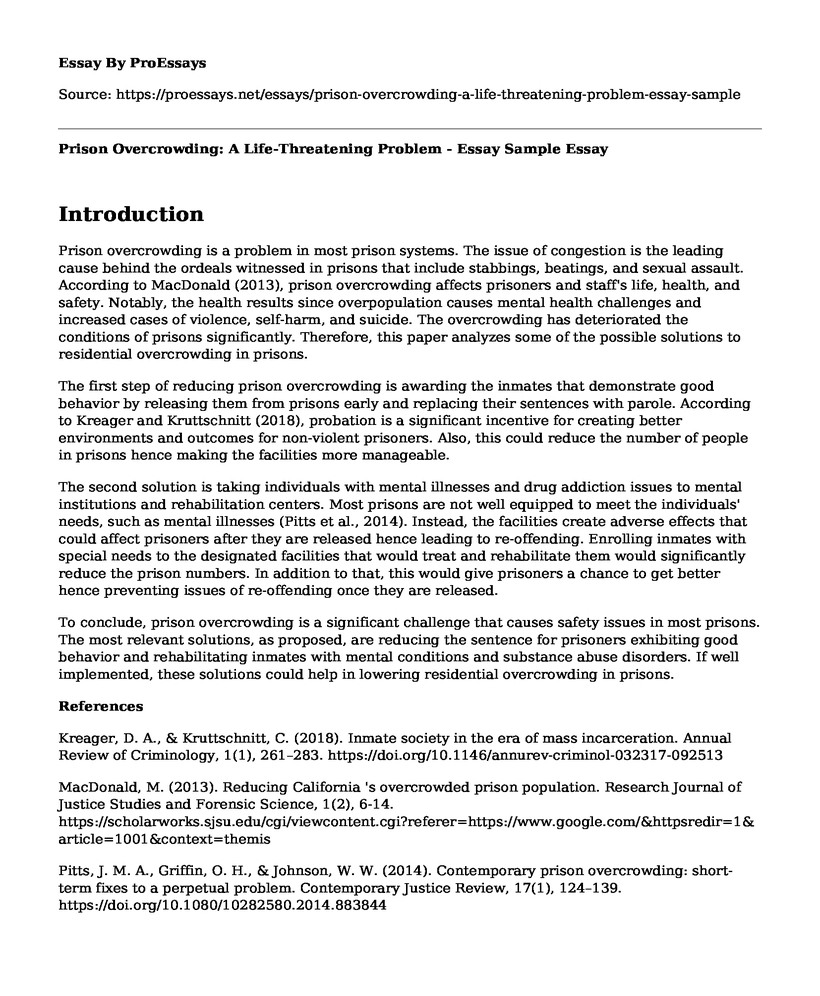Introduction
Prison overcrowding is a problem in most prison systems. The issue of congestion is the leading cause behind the ordeals witnessed in prisons that include stabbings, beatings, and sexual assault. According to MacDonald (2013), prison overcrowding affects prisoners and staff's life, health, and safety. Notably, the health results since overpopulation causes mental health challenges and increased cases of violence, self-harm, and suicide. The overcrowding has deteriorated the conditions of prisons significantly. Therefore, this paper analyzes some of the possible solutions to residential overcrowding in prisons.
The first step of reducing prison overcrowding is awarding the inmates that demonstrate good behavior by releasing them from prisons early and replacing their sentences with parole. According to Kreager and Kruttschnitt (2018), probation is a significant incentive for creating better environments and outcomes for non-violent prisoners. Also, this could reduce the number of people in prisons hence making the facilities more manageable.
The second solution is taking individuals with mental illnesses and drug addiction issues to mental institutions and rehabilitation centers. Most prisons are not well equipped to meet the individuals' needs, such as mental illnesses (Pitts et al., 2014). Instead, the facilities create adverse effects that could affect prisoners after they are released hence leading to re-offending. Enrolling inmates with special needs to the designated facilities that would treat and rehabilitate them would significantly reduce the prison numbers. In addition to that, this would give prisoners a chance to get better hence preventing issues of re-offending once they are released.
To conclude, prison overcrowding is a significant challenge that causes safety issues in most prisons. The most relevant solutions, as proposed, are reducing the sentence for prisoners exhibiting good behavior and rehabilitating inmates with mental conditions and substance abuse disorders. If well implemented, these solutions could help in lowering residential overcrowding in prisons.
References
Kreager, D. A., & Kruttschnitt, C. (2018). Inmate society in the era of mass incarceration. Annual Review of Criminology, 1(1), 261–283. https://doi.org/10.1146/annurev-criminol-032317-092513
MacDonald, M. (2013). Reducing California 's overcrowded prison population. Research Journal of Justice Studies and Forensic Science, 1(2), 6-14. https://scholarworks.sjsu.edu/cgi/viewcontent.cgi?referer=https://www.google.com/&httpsredir=1&article=1001&context=themis
Pitts, J. M. A., Griffin, O. H., & Johnson, W. W. (2014). Contemporary prison overcrowding: short-term fixes to a perpetual problem. Contemporary Justice Review, 17(1), 124–139. https://doi.org/10.1080/10282580.2014.883844
Cite this page
Prison Overcrowding: A Life-Threatening Problem - Essay Sample. (2023, Aug 14). Retrieved from https://proessays.net/essays/prison-overcrowding-a-life-threatening-problem-essay-sample
If you are the original author of this essay and no longer wish to have it published on the ProEssays website, please click below to request its removal:
- Research Paper on Death Sentence
- Stories From the Court by Matthew Thomas Essay Example
- No Crime: Ross Drives to Save Lives - Essay Sample
- 17th May 1954: Supreme Court Upholds Equality in Education for All - Essay Sample
- Essay on Protecting Patient Confidentiality: HIPAA & Beyond
- Paper Example on 4 Types of Evidence in Ramsey Case: Physical, Doc., Expert, DNA
- Hate Crime Laws Paper Example







